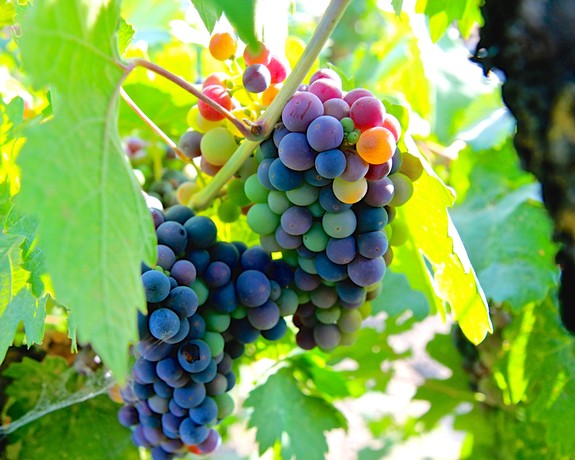Letters from Lodi
An insightful and objective look at viticulture and winemaking from the Lodi
Appellation and the growers and vintners behind these crafts. Told from the
perspective of multi-award winning wine journalist, Randy Caparoso.
In Lodi, Christmas (a.k.a. veraison) comes in July

Zinfandel during July veraison in Harney Lane Winery's Lizzy James Vineyard
The objective of Vitis, or grape vines, from their very beginning – speculated as dating back over a million years ago, based upon evidence of fossilized leaves and seeds – has always been the same as that of humankind: to bear fruit and multiply.
The almost miraculous changes we see in black skinned varieties of Vitis vinifera – the European species of vines always known to produce the finest wines – during the month of July in the Northern Hemisphere is a reflection of that basic objective.

Iconic ancient 115-year-old Marian's Vineyard Zinfandel during July veraison
At the beginning of the month individual berries are still going through a phase of berry cell division and cell expansion: while firm and green with chlorophyll, berries are growing into their maximum size, while their organic acid content is at its highest. The plant, in this phase, is still in its mama-bear mode – protective of its tender seeds as it builds a tough, acidic wall of pulp around them, the fruit still unedible to hungry animals.
Then suddenly, usually early in the month of July, something clicks: grapes enter their period known as veraison – taken from the French word véraison, in reference to “change of color” – when chlorophyll content begins to recede, and skins dramatically change from green to red, violet, blue to black colors.

Sorelle Vineyards Sangiovese during July veraison
As the multi-colored stage of veraison unfolds, grapes soften and sugars begin to accumulate, while acids steadily decline and cell division grinds to a halt. It is as if the plant has suddenly decided that it needs to begin to make itself more attractive to possible suitors; as the fruit transitions from green, herby, sour tastes to, eventually, a sweet, aromatic, luscious fruitiness. The softening skins of black skinned grapes begin to develop more flavonoid phenolics, adding to the fruit's edibility; and it is these phenolics that account for most of the aromas, flavors and sensory textures eventually expressed in a fermented red wine.

Bechthold Vineyard Cinsaut (Lodi's oldest vines, planted in 1886) just completing veraison at the end of July
In short, the grapes are suddenly saying, “take me!” In the wild, birds, deer, bears, and other animals would be there to pounce, the moment grapes reach a threshold where the taste of sweet fruitiness predominates over acidic sharpness (in vineyards beside natural corridors today, measures like nets, fences and raptors are utilized to discourage illicit munching). In the natural course of things, mature seeds would be excreted through animal waste, spread hither and yon where new vines can pop up. This is how varieties of Vitis managed to endure, and evolve, through hundreds of thousands of years, even through ages when the earth was buried mostly under ice.

Schmierer Vineyard Zinfandel during early July veraison
Winegrowers and winemakers, however, soon learned that it is best to wait a good 30 to 45 days after black skinned wine grapes go through veraison, to give clusters more time to develop optimal flavors; a window usually arriving in September or October, when sugar content climbs closer to 25% of grape volume – a percentage that translates into wines of 12% to 15% alcohol.

CLR Farms Syrah (east side of Lodi) during July veraison
During its evolution over millenniums, Vitis vinifera eventually mutated from dioecious (divided between male and female plants) to hermaphrodite (i.e. self-pollinating) vines; a characteristic that would become highly advantageous to the earliest enterprising grape growers, once they discovered that the natural yeast flora found on grape skins miraculously produce a delicious alcoholic beverage when put in contact with grape sugars. Unlike the way wild dioecious grape vines went forth and multiplied, it is possible to establish generations of self-pollinating vines as planted cuttings; thus assuring more predictable consistency of fruit and wine types.
Meanwhile, those of us who live in wine regions north of the equator can still enjoy the beautiful sights of veraison in July. It is like the visually stimulating start of a wine lover’s Christmas – we can hardly wait to unwrap the pleasures to come!

Silvaspoons Vineyards Tinta Roriz (a.k.a. Tempranillo) during July veraison